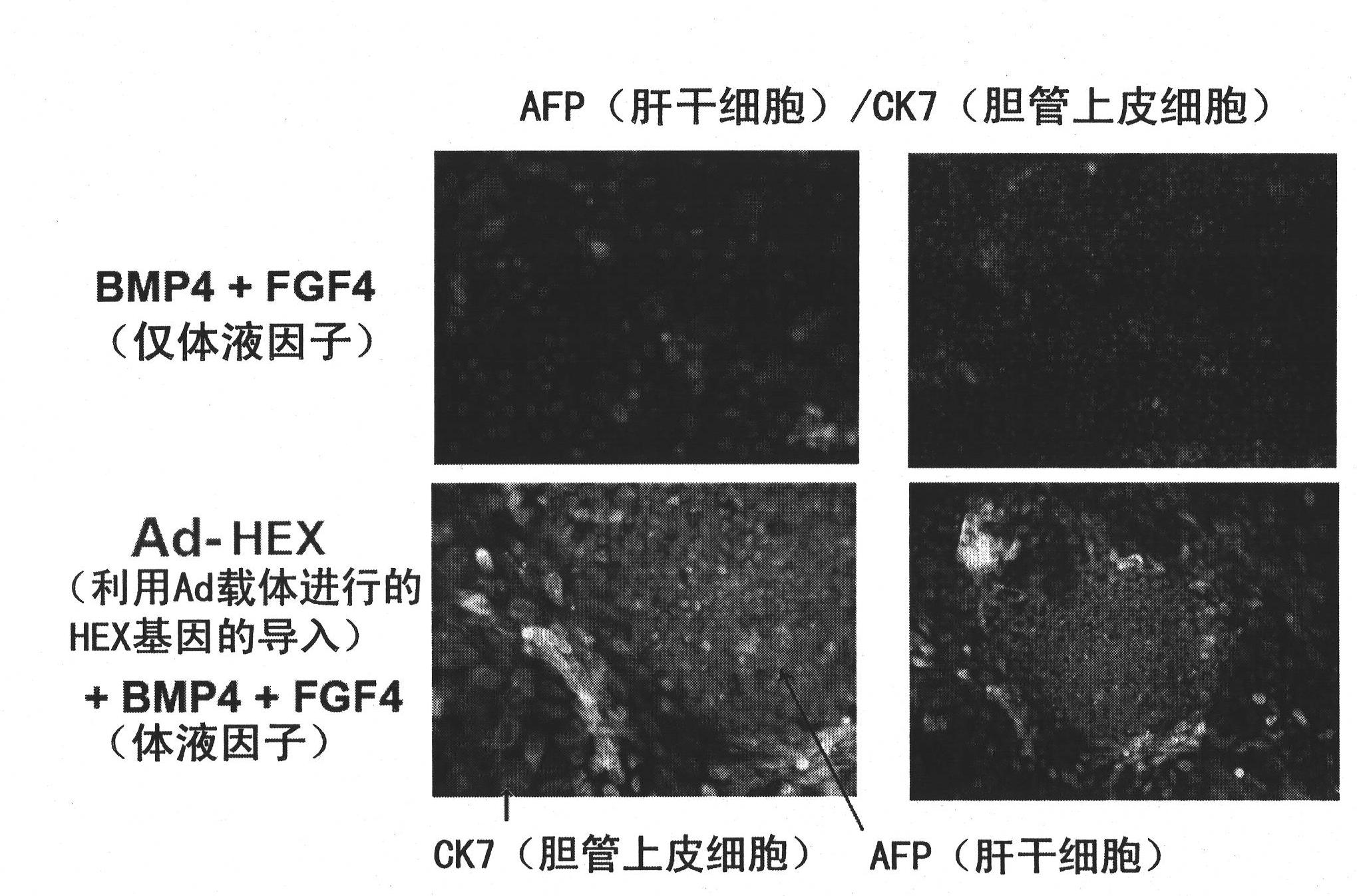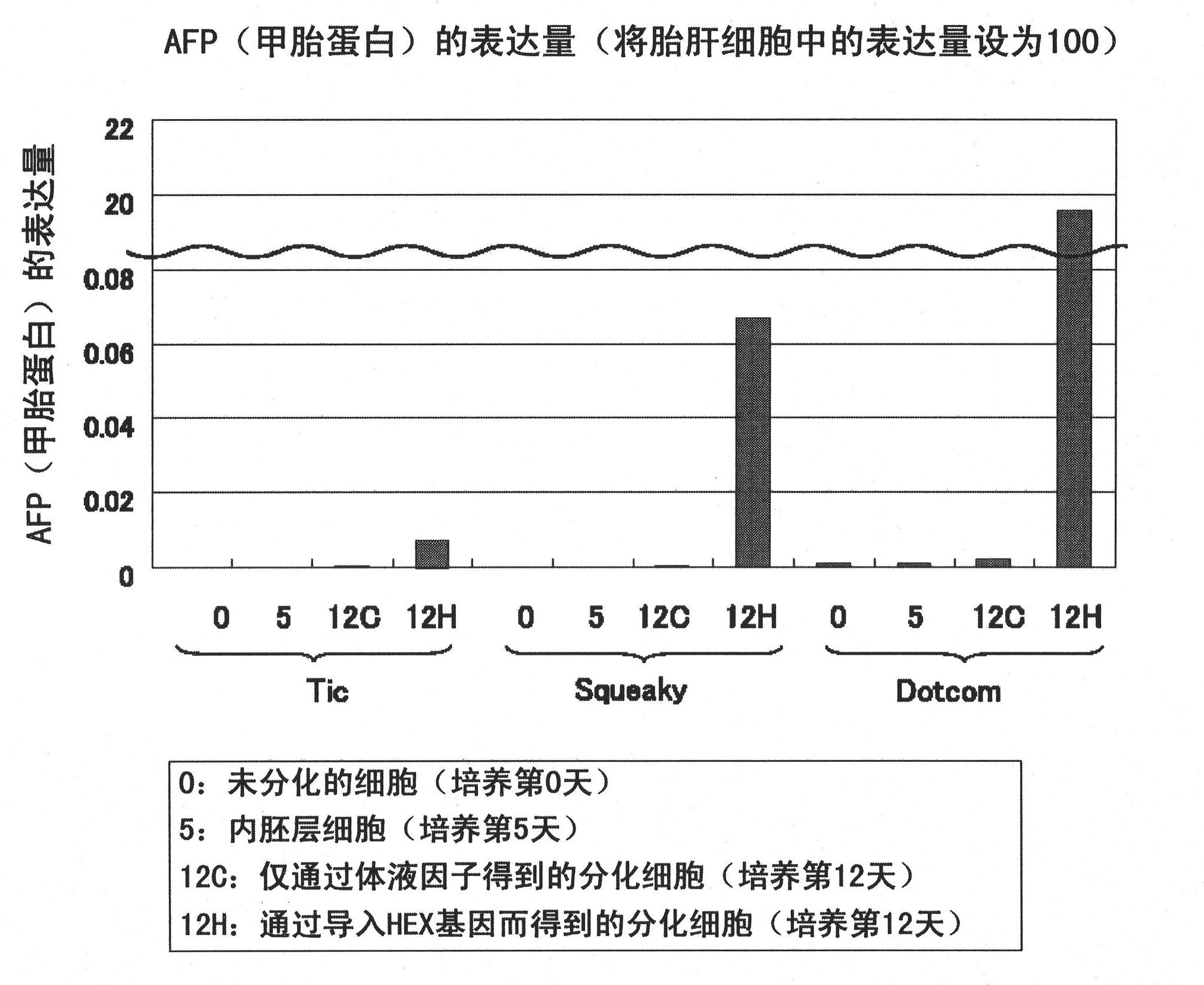Method for induction of differentiation of stem cells into hepatocytes
A technology for induction of differentiation and stem cells, applied in biochemical equipment and methods, embryonic cells, animal cells, etc., can solve problems such as the method of induction of stem cell differentiation that has not been disclosed
- Summary
- Abstract
- Description
- Claims
- Application Information
AI Technical Summary
Problems solved by technology
Method used
Image
Examples
Embodiment 1
[0105] (Example 1) Method for inducing differentiation from human iPS cells into hepatocytes
[0106] In this example, the case where the HEX gene was introduced into human iPS cells using an Ad vector and induced to differentiate into hepatocytes from the human iPS cells into which the gene was introduced will be described. The experimental route of this embodiment is shown in figure 1 .
[0107] 1) Construction of Ad vector for HEX gene introduction
[0108] An Ad vector was prepared in which an introduced gene was carried in the E1-deficient site of the E1-deficient type 5 Ad genome (pAdHM41-K7) and an EF-1α promoter was carried upstream thereof. The introduced gene is a HEX gene composed of the sequence shown in GenBank Accession No. BC014336.
[0109] 2) Culture of human iPS cells
[0110] In this example, human iPS cells (Tic (JCRB1331), Dotcom (JCRB1327), Squeaky (JCRB1329)) were used. Using mouse embryonic fibroblasts (MEF) as feeder cells, culture medium 1 shown ...
experiment example 1-1
[0116] (Experimental example 1-1) Results of antibody immunostaining method
[0117] On the 12th day of culture, immunological antibody staining was performed using an anti-alpha-fetoprotein (AFP) antibody (manufactured by Dako) labeled with Alexa (trademark) 594 and an anti-CK7 antibody (manufactured by Invitrogen) labeled with Alexa (trademark) 488 The expression of each gene was confirmed by the method. AFP is a marker of liver stem cells, and CK7 is a marker of bile duct epithelial cells. Such as figure 2 As shown, in the system into which the HEX gene was introduced using the Ad vector, stronger reactions of various markers were observed compared to the system without the gene. From this, it was confirmed that induction of differentiation from human iPS cells into hepatocytes was promoted by introducing the HEX gene using the Ad vector.
experiment example 1-2
[0118] (Experimental example 1-2) the result of real-time PCR method
[0119] For cells cultured on day 0 (undifferentiated cells), day 5 (endoderm cells) and day 12, the TaqMan (trademark) gene expression analysis kit (Applied Biosystems, catalog number: Hs01040607_m1 for AFP) was used. For albumin (Hs00910225_m), the expression levels of AFP and albumin, which can be markers of liver stem cells, were examined by real-time PCR. The expression level was calculated based on the expression level of each gene in human fetal liver total RNA (Clontech Company, catalog number 636540) as a benchmark (100).
[0120] As a result, both AFP and albumin were significantly increased in the HEX gene-introduced system, and it was found that the HEX gene-introduced system showed a tendency to induce differentiation ( image 3 , 4 ).
PUM
 Login to View More
Login to View More Abstract
Description
Claims
Application Information
 Login to View More
Login to View More - R&D
- Intellectual Property
- Life Sciences
- Materials
- Tech Scout
- Unparalleled Data Quality
- Higher Quality Content
- 60% Fewer Hallucinations
Browse by: Latest US Patents, China's latest patents, Technical Efficacy Thesaurus, Application Domain, Technology Topic, Popular Technical Reports.
© 2025 PatSnap. All rights reserved.Legal|Privacy policy|Modern Slavery Act Transparency Statement|Sitemap|About US| Contact US: help@patsnap.com



